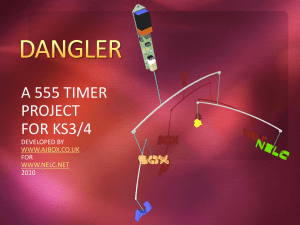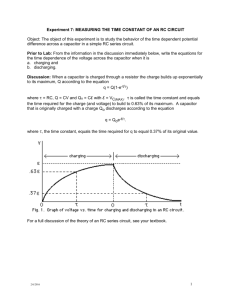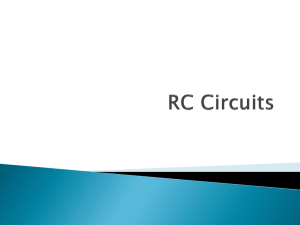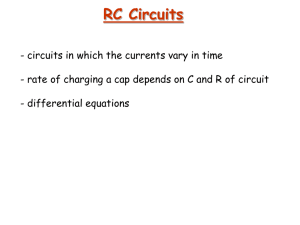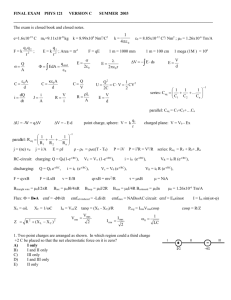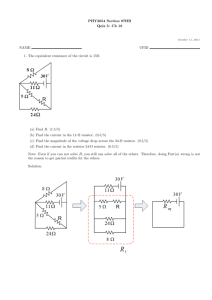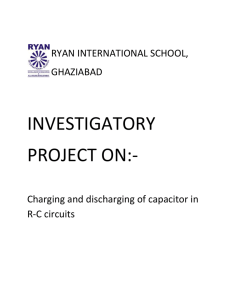RC Circuits Solution
advertisement
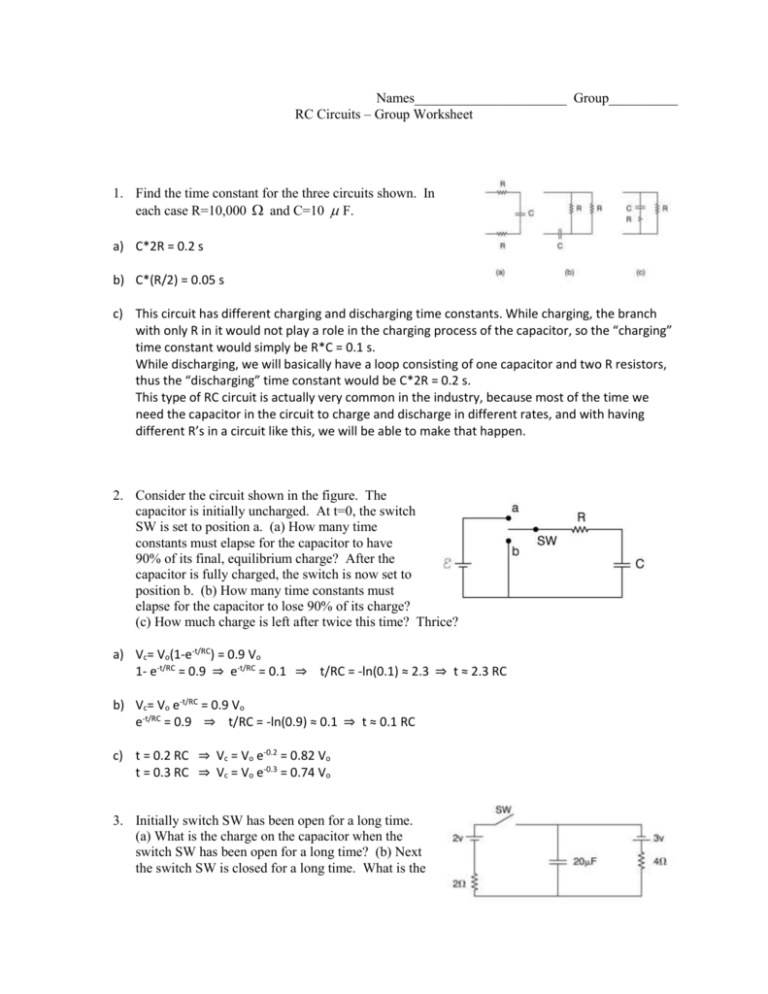
Names______________________ Group__________ RC Circuits – Group Worksheet 1. Find the time constant for the three circuits shown. In each case R=10,000 and C=10 F. a) C*2R = 0.2 s b) C*(R/2) = 0.05 s c) This circuit has different charging and discharging time constants. While charging, the branch with only R in it would not play a role in the charging process of the capacitor, so the “charging” time constant would simply be R*C = 0.1 s. While discharging, we will basically have a loop consisting of one capacitor and two R resistors, thus the “discharging” time constant would be C*2R = 0.2 s. This type of RC circuit is actually very common in the industry, because most of the time we need the capacitor in the circuit to charge and discharge in different rates, and with having different R’s in a circuit like this, we will be able to make that happen. 2. Consider the circuit shown in the figure. The capacitor is initially uncharged. At t=0, the switch SW is set to position a. (a) How many time constants must elapse for the capacitor to have 90% of its final, equilibrium charge? After the capacitor is fully charged, the switch is now set to position b. (b) How many time constants must elapse for the capacitor to lose 90% of its charge? (c) How much charge is left after twice this time? Thrice? a) Vc= Vo(1-e-t/RC) = 0.9 Vo 1- e-t/RC = 0.9 ⇒ e-t/RC = 0.1 ⇒ t/RC = -ln(0.1) ≈ 2.3 ⇒ t ≈ 2.3 RC b) Vc= Vo e-t/RC = 0.9 Vo e-t/RC = 0.9 ⇒ t/RC = -ln(0.9) ≈ 0.1 ⇒ t ≈ 0.1 RC c) t = 0.2 RC ⇒ Vc = Vo e-0.2 = 0.82 Vo t = 0.3 RC ⇒ Vc = Vo e-0.3 = 0.74 Vo 3. Initially switch SW has been open for a long time. (a) What is the charge on the capacitor when the switch SW has been open for a long time? (b) Next the switch SW is closed for a long time. What is the charge on the capacitor after the switch SW has been closed for a long time? a) Q = CV3 = 20 * 10-6 * 3 = 6 * 10-5 C b) After the switch is closed for a long time the circuit basically comes down to one equivalent battery of V3 – V2 = 1 V , and an equivalent resistor of 6 ohms. The charge on the capacitor at this time is: Q = CV = C (V3 – i4) = 20*10-6 F(0.3V)=6*10-6C where you solve for the current from the Kirchoff loop rule: 2V+3V-6i=0 4. Consider the RC-circuit shown to the right. Here, Ɛ=120V, R1=4.2kΩ, R2=4kΩ, R3=1kΩ and C=4.7mF. Initially the switch SW is open for a long time and the capacitor C is uncharged. The switch then is closed at t=0. (a) Find the values of i1 and i2 immediately after closing the switch, i.e., at t=0. (b) Find the values of i1 and i2 a long time after closing the switch. a) Immediately after closing the switch, the capacitor will act like a wire; thus we just have a circuit with three resistors. The equivalent resistance for this case will be: 1 1 Req = R1 + (𝑅 + 𝑅 ) -1 = 4.2 + 0.8 = 5 kΩ 2 3 i1 = Ɛ / Req = 120V / 5 kΩ = 24 mA From Kirchhoff’s junction rule we have: i1 = i2 + i3 , and from the loop rule for the small loop we have i3R3 – i2R2 = 0 . Thus: i1 = i2 + 𝑅2 i2 𝑅3 ⇒ i2 = 24/5 = 4.8 mA b) After the switch has been closed for a long time, no current will flow through the branch with the capacitor in it, so we will have a circuit with only resistors R1 and R2, thus i1 = i2. Req = R1 + R2 = 8.2 kΩ i1 = i2 = Ɛ / Req = 120V / 8.2 kΩ = 14.6 mA
![Sample_hold[1]](http://s2.studylib.net/store/data/005360237_1-66a09447be9ffd6ace4f3f67c2fef5c7-300x300.png)


